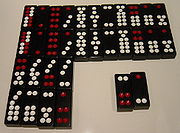
Chinese dominoes
Encyclopedia

Tile-based game
A tile-based game is a game that uses tiles as one of the fundamental elements of play. Traditional tile-based games use small tiles as playing pieces for gambling or entertainment games...
s, namely, Tien Gow
Tien Gow
Tianjiu is a Chinese trick-taking gambling game for 4 players.The game is played with a set of Chinese dominoes."Tianjiu" means literally heaven and nine...
, Pai Gow
Pai Gow
Pai gow is a Chinese gambling game, played with a set of Chinese dominoes. Pai gow is played in unsanctioned casinos in most Chinese communities...
, Che Deng
Che Deng
Che Deng literally means diagonal nails in Cantonese. It is the name of a Chinese game that plays with the Chinese dominoes set.Che refers to the diagonal pattern of the "three" pip on the tile....
, Tiu U and Kap Tai Shap. In Cantonese
Cantonese
Cantonese is a dialect spoken primarily in south China.Cantonese may also refer to:* Yue Chinese, the Chinese language that includes Cantonese* Cantonese cuisine, the cuisine of Guangdong province...
they are called 骨牌 "Gwat Pai", which literally means "bone tiles", it is also the name of a northern Chinese game, where the rules are quite different from the southern Chinese game Tien Gow. References to Chinese domino tiles can be traced to writings from the Song Dynasty (AD 1120). Chinese dominoes should not be confused with mahjong tiles
Mahjong tiles
Mahjong tiles are tiles of Chinese origin that are used to play many games, most notably Mahjong and Mahjong solitaire. Although they are most commonly tiles, they may also refer to playing cards with similar contents as well.- Construction :Traditionally, Mahjong tiles were made of bone, often...
, which use a different tileset.
Deck Composition and Ranking
Each tile pattern in the Chinese domino set is made up of the outcome of a throw of two six-sided diceDice
A die is a small throwable object with multiple resting positions, used for generating random numbers...
. There are therefore 21 unique patterns. A tile set consists of 32 tiles in two "suits" or groups called "military" and "civilian". There are no markings on the tiles to distinguish these suits; a player must simply remember which tiles belong to which group.
The tile set contains two each of eleven civilian suit tiles (6-6, 1-1, 4-4, 1-3, 5-5, 3-3, 2-2, 5-6, 4-6, 1-6, 1-5) and one each of ten military suit tiles (3-6, 4-5; 2-6, 3-5; 2-5, 3-4; 2-4; 1-4, 2-3; 1-2). Each civilian tile also has a Chinese name (and common rough translation to English): The 6-6 is tin (天 heaven), 1-1 is dei (地 earth), 4-4 is yan (人 man), 1-3 is ngo (鵝 goose or 和 harmony), 5-5 is mui (梅 plum flower), 3-3 is cheung (長 long), 2-2 is ban (板 board), 5-6 is fu (斧 hatchet), 4-6 is ping (屏 partition), 1-6 is tsat (七) (long leg seven), and 1-5 is luk (六) (big head six).
The civilian tiles are ranked according to the Chinese cultural significance of the tile names, and must be memorized. For example, heaven ranks higher than earth; earth ranks higher than man etc. Remembering the suits and rankings of the tiles is easier if one understands the Chinese names of the tiles and the symbolism behind them.
The military tiles are named and ranked according to the total points on the tiles. For example, the "nines" (3-6 and 4-5) rank higher than the "eights" (2-6 and 3-5).
The military tiles (since there is only one each) are also considered to be five mixed "pairs" (for example, the 3-6 and 4-5 tiles "match" because they have same total points and both in the military suit). Among the military tiles, individual tiles of the same pair (such as 1-4 and 2-3) rank equally. The 2-4 and 1-2 are an odd pair. They are the only tiles in the whole set that don't match other tiles in the normal sense. This pair when played together is considered a suit on its own, called the Gee Joon (至尊 Supreme). It is the highest ranking pair in the game of Pai Gow, though the tiles rank low individually (in their normal order). When a tile of this pair is played individually in the game of Tien Gow, each takes its regular ranking among other military suit tiles according to the total points. The rankings of the individual tiles are similar in most games. However, the ranking of combination tiles is slightly different in Pai Gow and Tien Gow.
Using the same coloring scheme of the traditional Chinese dice, every half-domino with 1 or 4 spots has those spots colored red (for example, the 4-5 domino has four red spots and five white spots). The only exception is the pair of 6-6 tiles. Half of the spots on the 6-6 domino are colored red to make them stand out as the top ranking tiles.
External links
- Rules of Domino games
- Pictures of the Chinese tiles
- an article dated back to 1893
- Dominoes Rules at Digital Gamers Rules for 9 Chinese, Korean, and Tibetan domino games

